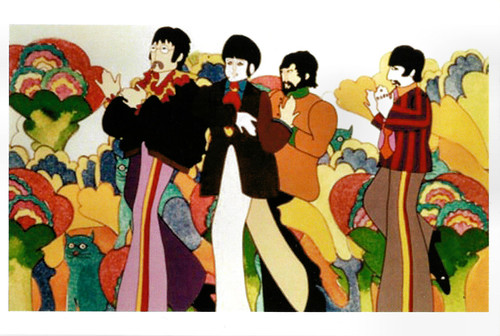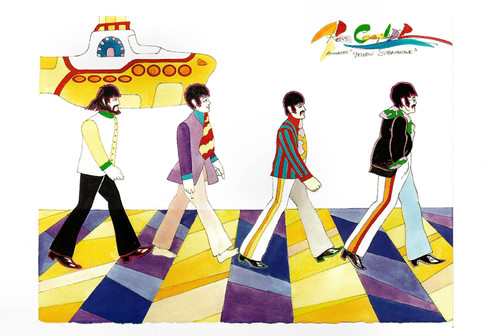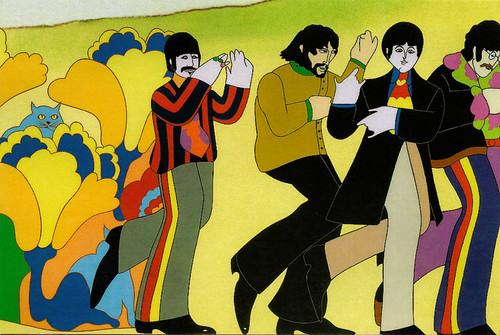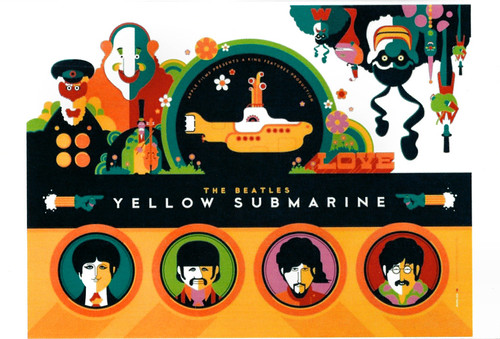
British postcard by London Postcard Company, no YS 5314 (Series 2 set of 9). Photo: Subafilms Ltd. Film image of The Yellow Submarine (George Dunning, 1968). Caption: Up on the hill.

British postcard by London Postcard Company, no YS 5314 (Series 2 set of 9). Photo: Subafilms Ltd. Film image of The Yellow Submarine (George Dunning, 1968). Caption: Up on the hill.

British postcard by London Postcard Company, no YS 5314 (Series 2 set of 9). Photo: Subafilms Ltd. Film image of The Yellow Submarine (George Dunning, 1968). Caption: Up on the hill.
A disappointing contract with United Artists
In 1963, the American film studio United Artists approached The Beatles' manager Brian Epstein for a contract to make a number of films around the group. Epstein saw the deal as a good way to promote The Beatles and sell their music. United Artists was particularly interested in the money that would come in from selling the music albums. The Beatles were under contract to Capitol Records in the US, but that agreement excluded music albums. The studio knew that album sales would always make money even if the film flopped, so they saw the film deal as one in which they could not lose.
On the other hand, the deal United Artists made with Epstein was not very favourable to John Lennon, Paul McCartney, George Harrison, and Ringo Starr. Epstein was not a good negotiator and was an amateur in many financial matters. Admittedly, The Beatles were not at their peak of popularity at the time (certainly not in the US), but even in that context, it was a disappointing contract. He had no idea of the normal profit percentages that could be negotiated, so he proposed a 7.5 % share. The United Artists studio bosses couldn't believe their luck; they had been afraid of tough negotiations and perhaps a higher percentage than 25%, and now Epstein came up with the ludicrous 7.5%. They immediately made a deal for three films.
Not long after, the Beatles' popularity shot through the roof, also in the US, and Richard Lester made the first Beatles film A Hard Day's Night (Richard Lester, 1964) one of the most successful films of all time. This did not only deprive The Beatles of millions in earnings. They were also stuck with a financially disappointing film contract that would hang around their necks like a millstone.
The second film that The Beatles made for United Artists was Help (Richard Lester, 1965). Although the film was as successful as its predecessor, the Beatles were not very enthusiastic about the end result. They were afraid of getting stuck in the format of "the happy adventures of the Beatles". But Brian Epstein had signed a contract with United Artists in 1963, and the film production company demanded a third film.
All sorts of ideas were floated, such as a film adaptation of J.R.R. Tolkien's 'The Lord of the Rings' with Ringo as Frodo and John as Gandalf, but the third film did not materialise. In 1967, the four Beatles thought they could direct themselves and made the television production Magical Mystery Tour. The TV movie was broadcast by the BBC in black and white and was received by viewers and critics with dismay. After this, The Beatles' interest in films dropped to a low point.
Their manager Brian Epstein came up with the solution. He was approached by Al Brodax, the head of King Features Syndicate, with the idea of making a full-length animated film based on a number of Beatles songs. The idea was based on the animated series about The Beatles that had been broadcast since 1965. TVC produced this series, in which an animated adventure was always made around a Beatles song. The Beatles were excited because they did not have to contribute to the film. But for this very reason, United Artists rejected Yellow Submarine as the third film. It was only with the documentary Let it Be that the Beatles fulfilled their contractual obligations.

British postcard by London Postcard Company, no YS 5314 (Series 2 set of 9). Photo: Subafilms Ltd. Film image of The Yellow Submarine (George Dunning, 1968). Caption: Up on the hill.

British postcard by London Postcard Company, no YS 5314 (Series 2 set of 9). Photo: Subafilms Ltd. Film image of The Yellow Submarine (George Dunning, 1968). Caption: Up on the hill.

British postcard by London Postcard Company, no YS 5314 (Series 2 set of 9). Photo: Subafilms Ltd. Film image of The Yellow Submarine (George Dunning, 1968). Caption: Up on the hill.
A modern fairy tale about the 1967 hippy generation
Yellow Submarine (George Dunning, 1968) was a hit in cinemas and the critics were also enthusiastic. Roger Ebert: "This is a story that appeals even to young children, but it also has a knowing, funny style that adds an undertow of sophistication. The narration and dialogue are credited to four writers (including 'Love Story's Erich Segal), and yet the overall tone is the one struck by John Lennon in his books 'In His Own Write' and 'A Spaniard in the Works'. Puns, drolleries, whimsies, and asides meander through the sentences: "There's a cyclops! He's got two eyes. Must be a bicyclops. It's a whole bicloplopedia!" The animation isn't full motion and usually remains within one plane, but there's nothing stiff or limited about it; it has a freedom of color and invention that never tires, and it takes a delight in visual paradoxes."
The animation of Yellow Submarine was groundbreaking in 1967. Until then, animation had been fairly traditional and dominated by Disney Studios. In Yellow Submarine, we see a psychedelic style, full of colour and effects. The man responsible for this form of animation was the German designer Heinz Edelmann. Later, Peter Max would develop the psychedelic style Edelmann used for the film and become famous for it. For this reason, it is sometimes claimed that Max stood at the cradle of Yellow Submarine, but he had nothing to do with the film. Edelmann would also influence designer/director Terry Gilliam on his animations for the TV shows Do Not Adjust Your Set and Monty Python's Flying Circus.
With over 200 employees, chief designer Edelmann and director Charles Dunning worked on the film for eleven months. The animators came from England, but also from the USA and other countries in Europe. The drawn appearance of The Beatles was based on the appearance of the real Beatles at the time of the recording of the film that accompanied the single 'Strawberry Fields Forever'. Only, Paul McCartney's moustache had disappeared from his alter ego in the film. The Beatles themselves, who had expected some kind of Disney film, were pleasantly surprised by the result of Yellow Submarine and decided to appear in the final scene themselves.
The starting point for the film was the song 'Yellow Submarine'. Paul McCartney wrote it as one of the songs that drummer Ringo Starr could sing with his limited singing voice. It was intended as a children's song with simple lyrics and melody. Subsequent accusations that "yellow submarines" were a code name for yellow pills, namely Nembutol capsules, so-called "downers" (hence "submarine": submarine) were dismissed by McCartney.
Producer Lee Minoff based himself on the idea of a children's song and wrote the first draft of the story. Soon, several scriptwriters were working on the scenario. It was decided to include a number of recent Beatles songs alongside 'Yellow Submarine'. Some of these songs were taken from the album 'Sgt. Pepper's Lonely Hearts Club Band'. This Beatles album, released in 1967, caused a sensation in the music world. The idea behind the album was that The Beatles were transformed into the fictional pop group Sgt. Pepper's Lonely Heart Club Band. On the cover, they can be seen in satin military uniforms in bright colours.
This was the impetus for the idea of including in the film a Sgt. Pepper who lives in Pepperland with his band. At one point, there were about twenty versions of the screenplay circulating. One of the writers was Roger McCough, a poet from Liverpool, who contributed much to the dialogues with their typical ambiguities, expressions from Liverpool, and private jokes from The Beatles. McCough received 500 pounds for his contribution, but no mention in the credits.
Mention was made of Jack Mendelsohn and Erich Segal. Mendelsohn had worked on the Beatles' animated series, but Segal was unfamiliar with the film business in 1967. He was working at Yale as an assistant to the professor of Classics. He was brought to London by Brodax to put together a coherent script from the large amount of material, some of which consisted only of fragments. Segal worked on the script continuously for several weeks under the threat of a deadline. He was barely allowed to leave his hotel room to jog. However, Segal was able to take advantage of a brilliant suggestion by Heinz Edelmann.
During a production meeting, the collaborators came to a disturbing conclusion: the screenplay lacked an enemy. Pepperland was a paradise without a snake. Edelmann came up with the concept of the Blue Meanies and their attack on everything that smelt of music. Incidentally, the meanies were originally red, entirely in keeping with the Cold War. An error by Edelmann's assistant caused the colours to be switched and the meanies became blue. Despite all the creative contributions, Yellow Submarine's screenplay also suffered from the fact that the music overshadowed the story and the story was adapted to the songs. It did result in a modern fairy tale about the 1967 hippy generation.

British postcard by London Postcard Company, no YS 5314 (Series 2 set of 9). Photo: Subafilms Ltd. Film image of The Yellow Submarine (George Dunning, 1968). Caption: Up on the hill.

British postcard by London Postcard Company, no YS 5314 (Series 2 set of 9). Photo: Subafilms Ltd. Film image of The Yellow Submarine (George Dunning, 1968). Caption: Up on the hill.

Italian postcard by Gruppo Editoriale Lo Vecchio, Genova. Picture: poster for The Yellow Submarine (George Dunning, 1968).
Source: Roger Ebert, Wikipedia (Dutch), and IMDb.
No comments:
Post a Comment